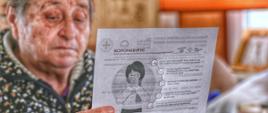Humanitarian environment in Donbas – war, isolation, quarantine
27.04.2020
Bogdan Rudkowski, a doctor with Caritas Mariupol working in Donbas, writes about helping those in need in Ukraine’s front-line area:

“The streets of towns and villages in the Donbas buffer zone, almost empty since the war, have now become completely deserted during quarantine. During these five years of the war, many people in the buffer zone who lost hope have come to terms with their grief and managed to once again believe in the present and the future, but... But trouble has knocked on the door of this microcosm again: the COVID-19 pandemic. These words frighten most people. An enemy you can’t see or hear. Days of quarantine are passing by. People need hope; people need help and support.”
In spite of the epidemic, Caritas Mariupol continues to operate in the buffer zone in eastern Ukraine as part of the project “Model of social services and medical care in Ukraine’s Donetsk region” with the support of the Solidarity Bridge Foundation and the Foreign Ministry’s Polish Aid.
50 carers in 13 villages of the buffer zone look after 150 elderly people in need, observing guidelines on safety precautions. The carers are always on the phone with their patients, respecting all the rules for preventing coronavirus infection recommended by the government and the World Health Organisation: keeping their distance, disinfecting items, applying hygiene measures, and airing the rooms. Two medical teams from Caritas Mariupol, each composed of a doctor and nurse, leave for the buffer zone twice a week. Three days a week they work remotely from the Caritas Mariupol Medical Centre. Doctors have developed a procedure for dealing with infection cases and for using safety measures during quarantine. Medical teams are monitoring the situation in the buffer zone through contacts with relevant authorities and site visits. During home visits, they regularly examine the carers and their patients for coronavirus symptoms. They run educational activities for the carers on how to prevent COVID-19, comply with hygiene measures, and contact the patients. They also conduct outreach campaigns in line with the WHO recommendations for preventing coronavirus infections among the residents of the buffer zone.
Elderly people living in the conflict area along the demarcation line represent over 40% of the population. Most of them have concomitant conditions, which puts them at a higher risk of infection and illness. The situation is complicated by the fact that they often have only limited access to basic hygiene products, clean water, food, and health services.
Since 12 March, public transport has been suspended in the area controlled by the Ukrainian government. This has made it more difficult to access groceries, pharmacies, healthcare facilities, banking, and other services. Villages in the buffer zone are now cut off from any help.
Since 16 March, the government restrictions on crossing the contact line have been in place and, since 22 March, the checkpoints between the Ukrainian government-controlled and uncontrolled area have been closed on both sides. This has hindered family relations and prevented the payment of pensions and social benefits for people from the area uncontrolled by the Ukrainian government. As a result, people are at risk of poverty and unable to pay for medicines and food.
In March, the UN Human Rights Monitoring Mission in Ukraine reported 19 conflict-related casualties (2 people killed and 17 wounded). This is an increase equal to the total number of reported casualties for the preceding five months. The situation in eastern Ukraine is still very volatile. Since March 2014, the conflict has affected more than 5.2 million people, of whom, according to EU estimates, 3.5 million still need humanitarian aid. Needs are constantly growing because of the poor financial situation of the affected population, mainly in areas that are not controlled by the Kyiv government. Access to humanitarian aid there is even more limited because of the coronavirus pandemic. The shelling in these areas makes it difficult to deliver essential supplies like water and electricity, on both sides of the demarcation line.
Prepared by Marta Titaniec, Solidarity Bridge Foundation



